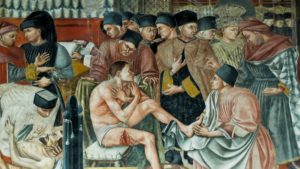Dr. Andrew J. Pottenger
NTS Alumnus (Class of 2009)
This year’s encounter with COVID-19 will likely live on in our memories for a long time.

Image: Domenico di Bartolo / Public domain
Such sweeping pandemics are relatively rare in our experience. This may be partly what frightens us about the current situation. It’s not what we expect to see dominating the news week after week. We don’t expect something like this to actually affect our lives as well as those we know and love.
Yet, here we are.
But, we’ve been here before. So, what can history tell us about how Christians might ‘shine’ through such dark circumstances as a global pandemic? I want to take us back to the church’s first experiences of what we’re facing today.
The Roman world’s first encounter with pandemic was what we commonly call the ‘Antonine Plague’ (mid- to late-2nd century). It was named for the Antonine dynasty of emperors—two of whom ruled together at this time, Marcus Aurelius and his brother Lucius Verus. The disease was so rampant that even the age’s greatest physician, Galen, was overwhelmed and fled Rome before Marcus Aurelius compelled his return. At the same time, the Romans faced a series of daunting challenges including foreign invasion and Verus’ death—possibly from the same sickness.
Christians suffered the same as anyone else, but also became targets of popular hostility and localized persecution. It was widely assumed they were responsible for the gods’ wrath. Even so, Christianity’s spread throughout the empire increased. So we can see two general Christian responses to the ‘Antonine plague’. First, Christians firmly held their faith to the point of martyrdom. Society’s pressure and conventional wisdom could not persuade them to abandon their worshipful devotion to Christ. Second, Christians did not go underground, but continued circulating their message and living it publicly. The growth of Christianity during this period indicates that more people embraced its message—even while society in general resisted.
The ‘Plague of Cyprian’ was an even more serious disaster for the Roman people nearly a century later. This pandemic is popularly named after the bishop of Carthage who wrote as an eyewitness in his treatise, ‘On the Mortality’. In addition to this plague, everyone also suffered from foreign invasions, civil war, political instability, economic devastation, famine, and various earthquakes. As before, the Romans sought to placate the gods and Christians suffered for refusing to fall in line.
Such misfortune, however, did not convince Christians that their faith was mistaken. Some, like Cyprian, chose to see these circumstances as an opportunity for their faith to grow. Just as the ancient Greek philosopher Socrates may once have said that ‘the unexamined life is not worth living’, so it seems Christians concluded here that the unchallenged faith is not worth believing. They chose hope, understanding that God could use even the worst disasters to strengthen and purify the hearts of His people.
Dionysius, bishop of Alexandria during the ‘plague of Cyprian’, observed another kind of response. Since they could no longer gather for worship as accustomed, Christians looked outward and creatively went above and beyond any human call of duty in loving those around them. They embodied God’s incarnational and sacrificial love by caring for the sick and burying the dead—often at the cost of their own health and even their lives … all while everyone else was running away! Again, Christianity flourished and, in the mid-4th century, even the ‘apostate’ emperor Julian recognized the value of their extraordinary acts of charity and hospitality.
Two hundred years after Cyprian’s plague the empire’s western half had ceased to exist, but the eastern half remained. Ruling this surviving portion from Constantinople in the mid-6th century, the emperor Justinian unknowingly gave his name to a third pandemic. The ‘Plague of Justinian’ occurred between the years 540-542 and recurred sporadically until about 750. The 6th-century church historian John of Ephesus wrote graphic descriptions, based on his own experience, of what was probably the worst of these three ancient pandemics.
Christians like John saw, heard, touched, and smelled circumstances permeated by death. Even in such a horrific situation—which could have caused anyone to wonder why God would allow it, or if there were any gods at all—believers such as John saw His holy, loving hand at work. If God was angry, then his wrath revealed divine justice, which called people to repentance and forgiveness. It did not mean that God had lost His temper. Even through the agony of suffering, the anguish of grief, and the horror of decaying bodies bursting open in the streets, Christians were compelled to prayer, worship, sharing with the needy, avoiding sin, and seeking to live holy lives.
With rare exceptions, COVID-19 is nothing like these three pandemics that shocked the Roman Empire in the 2nd, 3rd, and 6th centuries. This is not to minimize anyone’s suffering, healthcare workers’ sacrificial efforts, some politicians’ tireless efforts to lead effectively, or the grieving of those who have lost because of this virus. But we can be both challenged and inspired by looking back at the ways that Christians responded to such appalling catastrophes as terrorized the Romans long ago.
How do we observe God at work today, when so much of what we rely on as ‘normal’ is not as accessible as it used to be? Who is God revealing Himself to be through the circumstances we’re facing? How is God using this situation to speak His Word to us, and what does that Word have to say? How might He be moving us to love others in incarnational and sacrificial ways that go above and beyond any human call of duty?
One day, people may be looking back on us to see how we rose to the occasion.









